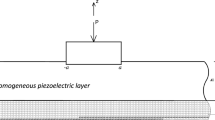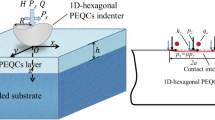Abstract
The receding contact problem between a graded piezoelectric layer and a homogeneous piezoelectric substrate is considered in this paper. It is assumed that the gradation of the elastic piezoelectric graded layer is of exponential type through its thickness. Using standard Fourier transform, the contact problem is converted to a system of two singular integral equations in which the contact pressures and the electric charge displacement in addition to the contact dimensions are the unknowns. The integral equations are then solved numerically using Gauss–Jacobi integration formula. The primary objective of this paper is to investigate the effect of material gradation on the contact pressure, electric charge distribution and on the length of the receding contact. The main findings of the paper are that the inhomogeneity parameter has a strong effect on the contact pressure and the electric charge distribution at the receding contact interface. It is concluded that a softer FGPM in \(+z\) direction results in lower contact pressure and electric displacement.








Similar content being viewed by others
References
Yilmaz, K.B., Comez, I., Yildirim, B., Güler, M.A., El-Borgi, S.: Frictional receding contact problem for a graded bilayer system indented by a rigid punch. International Journal of Mechanical Sciences 141, 127–142 (2018)
El-Borgi, S., Abdelmoula, R., Keer, L.: A receding contact plane problem between a functionally graded layer and a homogeneous substrate. International Journal of Solids and Structures 43(3–4), 658–674 (2006)
Rhimi, M., El-Borgi, S., Ben Said, W., Ben Jemaa, F.: A receding contact axisymmetric problem between a functionally graded layer and a homogeneous substrate. International Journal of Solids and Structures 46(20), 3633–3642 (2009)
Rhimi, M., El-Borgi, S., Lajnef, N.: A double receding contact axisymmetric problem between a functionally graded layer and a homogeneous substrate. Mechanics of Materials 43(12), 787–798 (2011)
El-Borgi, S., Usman, S., Güler, M.A.: A frictional receding contact plane problem between a functionally graded layer and a homogeneous substrate. International Journal of Solids and Structures 51(25–26), 4462–4476 (2014)
Yan, J., Li, X.: Double receding contact plane problem between a functionally graded layer and an elastic layer. European Journal of Mechanics-A/Solids 53, 143–150 (2015)
Yan, J., Mi, C.: On the receding contact between an inhomogeneously coated elastic layer and a homogeneous half-plane. Mechanics of Materials 112, 18–27 (2017)
El-Borgi, S., Çömez, I.: A receding frictional contact problem between a graded layer and a homogeneous substrate pressed by a rigid punch. Mechanics of Materials 114, 201–214 (2017)
Lopes, J.P., Hills, D.A.: The axisymmetric frictional receding contact of a layer pressed against a half-space by pressure outside a disk. European Journal of Mechanics-A/Solids 77, 103787 (2019)
KS Parel. Plane frictional receding contact of a thin layer pressed onto a substrate by finite pressure distributions. European Journal of Mechanics-A/Solids, page 104309, 2021
Cao, R., Li, L., Li, X., Mi, C.: On the frictional receding contact between a graded layer and an orthotropic substrate indented by a rigid flat-ended stamp. Mechanics of Materials 158, 103847 (2021)
Tian, X.J., Zhou, Y.T., Guan, X.F., Wang, L.H., Ding, S.H.: The frictional contact problem of a rigid punch sliding over thermoelectric materials. International Journal of Solids and Structures 200, 145–157 (2020)
Li, X., Tian, X.J., Zhou, Y.T.: Thickness size effect on contact behavior of a thermoelectric strip. Acta Mechanica , 1–17 (2021)
Liu, J., Ke, L.-L., Zhang, C.: Axisymmetric thermoelastic contact of an fgm-coated half-space under a rotating punch. Acta Mechanica , 1–18 (2021)
Zhou, Y.T., Tian, X.J., Li, F.J.: On coupling contact analysis of thermoelectric materials. Applied Mathematical Modelling 89, 1459–1474 (2021)
Ke, L.-L., Yang, J., Kitipornchai, S., Wang, Y.-S.: Electro-mechanical frictionless contact behavior of a functionally graded piezoelectric layered half-plane under a rigid punch. International Journal of Solids and Structures 45(11–12), 3313–3333 (2008)
Ke, L.-L., Yang, J., Kitipornchai, S., Wang, Y.-S.: Frictionless contact analysis of a functionally graded piezoelectric layered half-plane. Smart Materials and Structures 17(2), 025003 (2008)
Su, J., Ke, L.-L., Wang, Y.-S.: Fretting contact of a functionally graded piezoelectric layered half-plane under a conducting punch. Smart Materials and Structures 25(2), 025014 (2016)
Liu, T.-J., Zhang, C.: Axisymmetric conducting indenter on a functionally graded piezoelectric coating. International Journal of Mechanical Sciences 115, 34–44 (2016)
Liu, T.-J., Li, P., Zhang, C.: On contact problem with finite friction for a graded piezoelectric coating under an insulating spherical indenter. International Journal of Engineering Science 121, 1–13 (2017)
Su, J., Ke, L.-L., El-Borgi, S., Xiang, Y., Wang, Y.-S.: An effective method for the sliding frictional contact of a conducting cylindrical punch on fgpms. International Journal of Solids and Structures 141, 127–136 (2018)
Zhou, Y.-T., Zhang, C., Zhong, Z., Wang, L.: Transient thermo-electro-elastic contact analysis of a sliding punch acting on a functionally graded piezoelectric strip under non-fourier heat conduction. European Journal of Mechanics-A/Solids 73, 90–100 (2019)
Tian, X.J., Zhou, Y.T., Wang, L.H., Ding, S.H.: Surface contact behavior of functionally graded thermoelectric materials indented by a conducting punch. Applied Mathematics 42(5), 649–664 (2021)
Giannakopoulos, A.E., Suresh, S.: Theory of indentation of piezoelectric materials. Acta materialia 47(7), 2153–2164 (1999)
Erdogan, F., Gupta, G.D.: On the numerical solution of singular integral equations. Quarterly of Applied Mathematics 29, 525–534 (1972)
Acknowledgements
The first author is grateful for the funding provided by Texas A&M University at Qatar. The authors are also grateful for the help of Mrs. Hedia Layouni El-Borgi in typesetting the Latex document.
Author information
Authors and Affiliations
Corresponding author
Ethics declarations
Conflict of interest
On behalf of all authors, the corresponding author states that there is no conflict of interest.
Additional information
Publisher's Note
Springer Nature remains neutral with regard to jurisdictional claims in published maps and institutional affiliations.
Appendix A
Appendix A
1.1 Expressions of quantities appearing in Eq. (17)
1.2 Expressions of quantities appearing in Eq. (24)
1.3 Expressions of quantities appearing in Eqs. (33) and (34)
1.4 Expressions of quantities appearing in Eqs. (35) and (36)
1.5 Expressions of quantities appearing in Eq. (39)
Rights and permissions
About this article
Cite this article
El-Borgi, S., Çömez, I. & Ali Güler, M. A receding contact problem between a graded piezoelectric layer and a piezoelectric substrate. Arch Appl Mech 91, 4835–4854 (2021). https://doi.org/10.1007/s00419-021-02037-6
Received:
Accepted:
Published:
Issue Date:
DOI: https://doi.org/10.1007/s00419-021-02037-6




